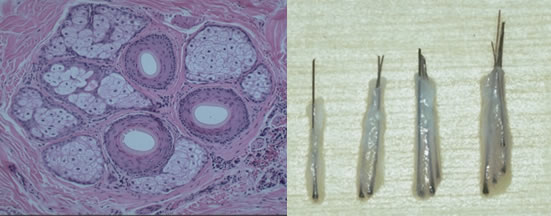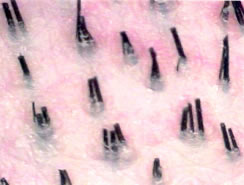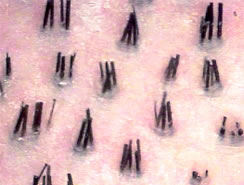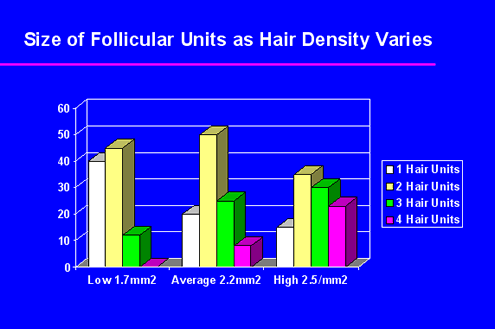For years it was thought that scalp hair grew as individual strands, but scalp hair actually grows in tiny little groups of 1-4 hairs each. These groups are called “follicular units.” Surprisingly, even after doctors learned about the existence of these groups, they didn’t think to use them in the hair transplant.

From a distance, it is hard to appreciate these distinct groups. Even on close inspection these groups can easily go unnoticed.

However, if one clips the hair short (to approx 1-mm) and then looks at the scalp under 30x magnification, using an instrument called a densitometer, the groups become readily visible. These hairs are grouped on the surface of the scalp because they represent the tops of the naturally occurring follicular units that lie below. It is the transplantation of these follicular units, rather than the larger mini-micrografts or plugs that has revolutionized modern hair transplantation and surgical hair restoration.

The follicular unit not only consists of a small group of hair follicles (three units are shown in the above photo on the left), but it also contains nerves, blood vessels and a tiny muscle called the erector pilorum (this is the same muscle that makes a cat’s hairs stand on end when it wants to look threatening). The whole unit is packaged in collagen that surrounds it and makes the follicular unit a distinct structure. See “Follicular Transplantation“.
Because follicular units are complete anatomic and physiologic structures, keeping them intact during the follicular hair transplant will ensure their maximum survival and growth. Follicular units are very small structures, however, and only careful stereo-microscopic dissection by a skilled and experienced surgical team can ensure that they will be kept whole and will not be damaged during the various phases of the hair restoration process.
The photo on the right shows 1-, 2-, 3-, and 4-hair follicular units that have been isolated from a donor strip using a dissecting stereo-microscope. The four follicular unit grafts are ready for implantation into the patient’s scalp. In the surgical hair restoration, each will play a different role and occupy a different position on the patient’s scalp.

A major advantage of using follicular units in hair transplant surgery is to be able to keep the recipient sites as small as possible. One can see from the above illustration (figure A on the left) that a 3-hair micrograft (comprised of a 2-hair follicular unit combined with a 1-hair follicular unit) produces a hair graft that is significantly larger than a graft made from a naturally occurring 3-hair follicular unit. The micrograft has a diameter that is 50% greater than the follicular unit and a volume over two times as great, so the recipient site needed to hold the micrograft would need to be over 2x as great as the follicular unit.
The smaller the recipient sites, the closer together they can safely be placed in the scalp. Small recipient sites also allow larger numbers of grafts to be safely transplanted in one hair restoration session without injuring the scalp or compromising its blood supply. Therefore, using follicular units maximizes the density of grafts that can be transplanted in one session and the number than can safely be used at any one time.
The look of fullness in a follicular unit transplant is not only dependent on the number of hair grafts but on the number of hairs each graft contains. Since the hairs in the follicular unit are very close together, transplanting follicular units allows the most hair to be placed into the smallest possible recipient sites, giving maximum fullness to the hair transplantation procedure. This guarantees that these grafts will not appear pluggy, because follicular units represent the way hair grows in nature. Although using follicular units prevents a pluggy look, they must be placed in the proper direction and distribution to ensure a totally natural appearance to the hair restoration.
Using hair grafts larger than follicular units will always compromise naturalness in the hair transplant and using grafts smaller than follicular units will always result in less fullness.
The patient in the above right photo is in the process of having a follicular unit hair transplant of 2,002 grafts. Because the follicular units are so small and compact, they are able to fit into tiny recipient sites. Over 2,000 of these sites were safely created in the front part of the patient’s scalp to accommodate these hair grafts. This patient’s progress can be viewed on the Hair Transplant Photo Journal page.
Every individual has his, or her, own characteristic pattern of follicular units which give a unique appearance to one’s hair. The following photos, taken through a densitometer, show the follicular unit “fingerprint” of two different patients. The person on the left has an average density and the person on the right, a very high density. Both represent the normal way that hair grows in the scalp.
In performing Follicular Unit Transplantation (FUT), these naturally occurring groups of 1-4 hairs should be kept intact. As a result of the natural variation in follicular unit size, the person on the right will have more fullness from his/her hair restoration than the person on the left. If one were to try to combine follicular units in the patient on the left (i.e. use 5-hair grafts that contained 3-hair follicular units and 2-hair follicular units placed together) in order to achieve greater fullness, one would only produce an unnatural look — without any increase in fullness. The reason is that the larger follicular units that look perfectly natural in the person on the right would look unnatural in the person on the left (they would stand out like “sore thumbs”). Using only follicular units in the hair transplant ensures a totally natural result. For a more detailed explanation of these concepts see The Logic of Follicular Unit Transplantation.
 Average Density (2.2 hairs/follicular unit)
Average Density (2.2 hairs/follicular unit) Very High Density (3.2 hair/follicular unit)
Very High Density (3.2 hair/follicular unit)In planning hair follicle transplant surgery, it is important to have knowledge of the approximate proportion of each of the different size follicular units in a person’s scalp (this information should be obtained with a densitometer during the initial consultation). This data is important in planning the hair restoration, since the larger units can be concentrated in select areas to create the appearance of greater central fullness, while the smaller units can be used to create a soft, natural hairline and temples. Having this information helps to determine the total number of follicular units that need to be harvested in one particular follicular hair transplant session.

As seen in the graph above, patients with low hair density will have fewer hairs per follicular unit (with a preponderance of 1- and 2- hair follicular units) and those with higher density will have a greater proportion of the larger 3- and 4-hair units.
Other characteristics of the follicular unit; such as hair color, wave, and hair shaft diameter; are important in determining the outcome of the hair restoration. Hair shaft diameter, which differs significantly among individuals, is particularly important in affecting the degree of fullness that can be obtained from a follicular unit transplant. In fact, hair shaft diameter contributes more to the look of fullness obtained from a hair transplant than hair density (number of hairs per cm2). See Measurements in Hair Restoration.
As discussed in the Causes of Hair Loss section, the presence of miniaturized hair (hairs of decreased diameter) in the follicular unit suggests that the hair in that area will continue to thin. This information is useful not only in anticipating further hair loss, but in determining the quantity and ultimate stability of a patient’s donor hair supply.
In sum, knowledge of the patient’s follicular unit “fingerprint” is critical to the diagnosis of hair loss and the proper planning of every follicular hair transplant surgery. This information should be available to the physician when the decision making process begins.
The follicular unit was first described in 1984 by the pathologist Dr. John Headington in the paper, “Transverse microscopic anatomy of the human scalp.” The technique for isolating follicular units using a microscope was first described by Dr. Bobby Limmer and published in his 1994 paper, “Elliptical donor stereoscopically assisted micrografting as an approach to further refinement in hair transplantation.”
The term “follicular unit” was introduced into the hair transplant literature by Drs. Robert Bernstein and William Rassman in their 1995 publication, “Follicular Transplantation.” In this paper, Dr. Bernstein first proposed that the entire surgical hair restoration should be accomplished using only follicular units — tiny, naturally occurring groups of hair. In a series of medical publications that followed, Bernstein and Rassman defined the procedure of follicular unit transplantation and offered guidelines on how the technique should be best used to maximize the patient’s long-term results. In “Standardizing the Classification and Description of Follicular Unit Transplantation,” Dr. Bernstein and his colleagues formally changed the name of the procedure to Follicular Unit Transplantation.




